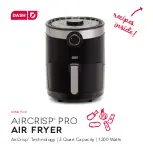
8
GAS CONNECTIONS
CAUTION: All gas supply connections and any
pipe joint compound must be resistant to the
action of propane gases.
The gas inlet is located at the lower right rear. Codes
require that a gas shutoff valve be installed in the gas
line ahead of the fryer.
The gas supply line must be at least the equivalent of
1
⁄
2
" iron pipe. If using the optional quick-disconnect
flex hose,
3
⁄
4
" iron pipe must be used unless
3
⁄
4
" to
1
⁄
2
" reducing fittings are used. Make sure the pipes
are clean and free of obstructions, dirt, and
piping compound. A battery requires one or two
connections of appropriate size and type for the
gas requirement.
WARNING:
PRIOR TO LIGHTING, CHECK ALL
JOINTS IN THE GAS SUPPLY LINE FOR LEAKS.
USE SOAP AND WATER SOLUTION. DO NOT USE
AN OPEN FLAME.
After piping has been checked for leaks, fully purge
gas pipes to remove air.
GAS PRESSURES AND ORIFICES
The standard orifices are set at 4" W.C. (Water
Column) pressure for natural gas and 10" W.C.
(Water Column) pressure for propane gas. A
pressure regulator is supplied as part of the gas
control valve.
TESTING THE GAS SUPPLY PIPING SYSTEM
When test pressures exceed
1
⁄
2
psig (3.45 kPa),
the fryer and its individual shutoff valve must be
disconnected from the gas supply piping system.
When test pressures are
1
⁄
2
psig (3.45 kPa) or
less, the fryer must be isolated from the gas
supply piping system by closing its individual
shutoff valve.
LEVELING THE FRYER
Once gas connections have been made, place a
spirit level on top of the fryer. Adjust the legs to
ensure that the fryer is level front-to-back and
side-to-side in the final installed position.
FLUE CONNECTIONS
The fryer must be located under a hood which has
an adequate connection to an exhaust duct. The
hood must extend 6" beyond fryer sides.
Adequate ventilation must be provided and must
comply with NFPA Standard #96, (latest edition),
and with local codes.
Clearance above fryer should be adequate for
products of combustion to be removed efficiently.
An 18" minimum clearance should be maintained
between the flue vent and the filters of the hood
venting system.
Never make flue connections directly to the fryer.
Do not obstruct the flow of the flue gases from the
flue duct located at the rear of the appliance.
Adequate air should be provided in the kitchen to
replace air taken out by the ventilating system.
This will prevent fryer function from being affected
by a reduced atmospheric pressure.
ELECTRICAL CONNECTIONS
WARNING:
ELECTRICAL AND GROUNDING
CONNECTIONS MUST COMPLY WITH THE
NATIONAL ELECTRICAL CODE, ANSI/NFPA 70
OR THE CANADIAN ELECTRICAL CODE, CSA
C22.2 AND/OR OTHER LOCAL CODES.
WARNING:
APPLIANCES EQUIPPED WITH
ELECTRICAL SUPPLY CORD(S) ARE PROVIDED
WITH A THREE-PRONG GROUNDING PLUG
WHICH MUST BE CONNECTED TO A PROPERLY
GROUNDED RECEPTACLE. IF THE RECEPTACLE
IS NOT THE PROPER GROUNDING TYPE,
CONTACT AN ELECTRICIAN. DO NOT REMOVE
THE GROUNDING PRONG FROM THE PLUG.
Some fryers (depending on options) are equipped
with a 120 Volt/60 Hz./1 Phase cord and plug
which requires only that it be plugged into a
properly grounded 120 volt receptacle.
Do not connect fryer to electrical supply until after
gas connections have been made.


































